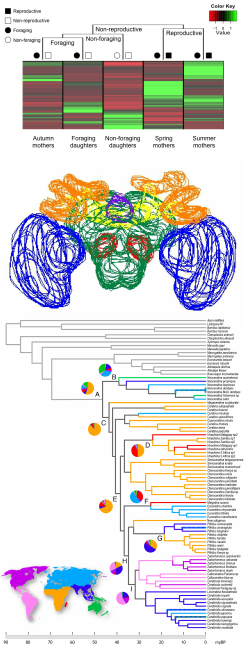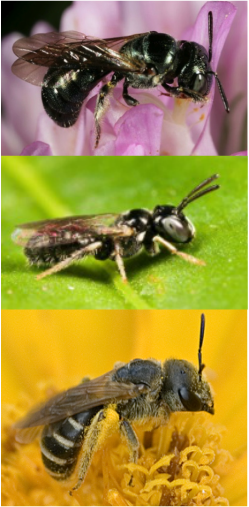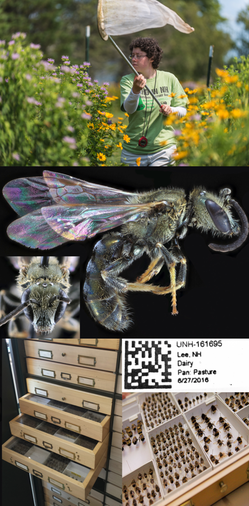Comparative Genomics |

Currently we are sequencing the genomes of sixteen bee and wasp species to ask questions on the genetic changes associated with the transition from solitary to eusocial behaviour. The carpenter bees (Hymenoptera: Xylocopinae) exhibit the full social spectrum from solitary to advanced eusocial colony organization. Carpenter bees offer unique opportunities to study molecular evolution of complex traits including the origin and maintenance of social group formation and the elaboration of social castes.
We are conducting comparative studies of brain gene expression using next generation sequencing of the small carpenter bees, genus Ceratina, with emphasis on understanding regulatory mechanisms of cooperation and conflict in varying social contexts. We also study the nutritional ecology of wild bees, focusing on Ceratina species, to determine the plant diversity, habitat requirements, microbiota, and potential pathogens in nest pollen. In addition to the integrated study of small carpenter bee genomics and transcriptomics to understand pollinator health, these studies are developing genomic resources for ongoing research on the genetic and epigenetic underpinnings of parental care and cooperative behaviour in incipiently social species.
We use molecular phylogeny to highlight species and clades of interest to study the transitions from solitary to social behaviour. We use DNA sequence and fossil calibration points to understand the evolutionary relationships among lineages. Using Bayesian techniques we have elucidated the age and origin of sociality in the carpenter bee subfamily, Xylocopinae. In addition we have used ancestral state reconstruction to test predictions on the role of ecological niche competition on the historical biogeography of the bees. We have uncovered evidence for extinction events which have important implications for our understanding of plant-pollinator co-evolution.
We are conducting comparative studies of brain gene expression using next generation sequencing of the small carpenter bees, genus Ceratina, with emphasis on understanding regulatory mechanisms of cooperation and conflict in varying social contexts. We also study the nutritional ecology of wild bees, focusing on Ceratina species, to determine the plant diversity, habitat requirements, microbiota, and potential pathogens in nest pollen. In addition to the integrated study of small carpenter bee genomics and transcriptomics to understand pollinator health, these studies are developing genomic resources for ongoing research on the genetic and epigenetic underpinnings of parental care and cooperative behaviour in incipiently social species.
We use molecular phylogeny to highlight species and clades of interest to study the transitions from solitary to social behaviour. We use DNA sequence and fossil calibration points to understand the evolutionary relationships among lineages. Using Bayesian techniques we have elucidated the age and origin of sociality in the carpenter bee subfamily, Xylocopinae. In addition we have used ancestral state reconstruction to test predictions on the role of ecological niche competition on the historical biogeography of the bees. We have uncovered evidence for extinction events which have important implications for our understanding of plant-pollinator co-evolution.
Behavioural Ecology

We examine the roles of ecological constraints and physical coercion on the division of labour and maintenance of alternate reproductive strategies in facultatively social bees. Using protein and DNA sequence comparisons, we are able to obtain kinship and relatedness estimates using population genetic techniques. Combined, these long term studies of the life history, nesting biology, brood productivity, natural enemies, and relatedness of facultatively social bees have allowed for assessment of mutual tolerance, maternal manipulation, and inclusive fitness as explanations for social behaviour.
Long-term study of a facultatively social bee in Australia has provided a natural experiment to assess the inclusive fitness of solitary and social colonies in sympatry. This unprecedented empirical assessment of brood productivity and parasitism rates among reproductive strategies provide evidence that rare ecological constraints might be sufficient for understanding the maintenance of sociality in totipotent (non-caste differentiated) insect societies.
We also have ongoing comparative studies of facultatively social bees, both in North America and abroad, to elucidate the role of local ecology and phylogenetic inertia on the social plasticity of primitively social bees. There are approximately 20,000 species of bees worldwide and roughly 4,000 species in North America ... so many bees, so little time :)
Long-term study of a facultatively social bee in Australia has provided a natural experiment to assess the inclusive fitness of solitary and social colonies in sympatry. This unprecedented empirical assessment of brood productivity and parasitism rates among reproductive strategies provide evidence that rare ecological constraints might be sufficient for understanding the maintenance of sociality in totipotent (non-caste differentiated) insect societies.
We also have ongoing comparative studies of facultatively social bees, both in North America and abroad, to elucidate the role of local ecology and phylogenetic inertia on the social plasticity of primitively social bees. There are approximately 20,000 species of bees worldwide and roughly 4,000 species in North America ... so many bees, so little time :)
Biodiversity and Conservation

The conservation of wild pollinators requires in-depth knowledge of their diversity, habitat requirements, and responses to environmental stress. We conduct long term studies of bee biodiversity across agricultural landscapes and urban land use gradients to determine plant-pollinator associations and the stability of wild bee communities. Historical data and experimental manipulation of farm, forest, and urban settings allows us to determine how bees respond to land use change and human disturbance.
In studying biodiversity, we have a strong passion for documenting these charismatic species. Using macrophotography and microscope imaging, we are able to capture the distinct morphologies and showcase the beauty of wild bees. We also use these techniques to aid in training bee taxonomy, archiving museum specimens, and describing new species.
We take special interest in the accessibility, preservation, and digitization of historic specimens. Museum specimens offer invaluable data to discover cryptic species, study species ranges, adaptation, and ecological niches using comparative morphology, population genetic, and geospatial modelling techniques. We have digitized and georeferenced 20,000+ bee records as well as their floral associations dating back over 150 years. We are currently using these data to determine the habitat requirements and status of wild bee species to make sustainable land use, development, restoration, and conservation recommendations.
In studying biodiversity, we have a strong passion for documenting these charismatic species. Using macrophotography and microscope imaging, we are able to capture the distinct morphologies and showcase the beauty of wild bees. We also use these techniques to aid in training bee taxonomy, archiving museum specimens, and describing new species.
We take special interest in the accessibility, preservation, and digitization of historic specimens. Museum specimens offer invaluable data to discover cryptic species, study species ranges, adaptation, and ecological niches using comparative morphology, population genetic, and geospatial modelling techniques. We have digitized and georeferenced 20,000+ bee records as well as their floral associations dating back over 150 years. We are currently using these data to determine the habitat requirements and status of wild bee species to make sustainable land use, development, restoration, and conservation recommendations.
Interviews and Research Highlights - Tedx Talk
What happens to mother bees' brains as they age?
For more information on Bee Research @ York please click here
to visit the Bee Ecology, Evolution and Conservation research group
to visit the Bee Ecology, Evolution and Conservation research group